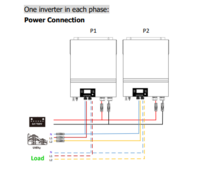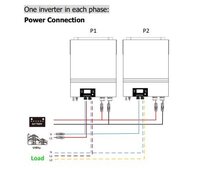RaiderRC
New Member
Hello,
I'm fairly new to this but have been a hobbyist for years. I also have some electrical engineering background. I'm in the process of setting up my first off-grid system for a full-time RV (5th wheel) boondocking setup and am looking for advice from the Prowse community. I have a plan that I think should work, but I'm seeking feedback in case there are any glaring issues. My main reason for posting is to find out about the LV6548 inverters.
Solar:
The entire roof as much as possible, taking off all the roof top AC/s removing generator and installing a dual zone split system.
Batteries:
2x 48v 100Ah rack mounted, can expand later
Inverters:
2x LV6548
The need is for full time live streaming with 2 PC's as well as being able to power an 11Kw instant hot water heater, welder, and compressor if needed. Obviously not all at the same time.
My main question here is, can I use a 120VAC input and still use the inverters as a 240VAC output?
The manual recommends

But what if my input power from an RV park or generator only provides 1 leg or a 30amp service.

I know that you can't connect L1 on the input to both units as it will damage the system.
Does anyone know if this method will work?
I'm fairly new to this but have been a hobbyist for years. I also have some electrical engineering background. I'm in the process of setting up my first off-grid system for a full-time RV (5th wheel) boondocking setup and am looking for advice from the Prowse community. I have a plan that I think should work, but I'm seeking feedback in case there are any glaring issues. My main reason for posting is to find out about the LV6548 inverters.
Solar:
The entire roof as much as possible, taking off all the roof top AC/s removing generator and installing a dual zone split system.
Batteries:
2x 48v 100Ah rack mounted, can expand later
Inverters:
2x LV6548
The need is for full time live streaming with 2 PC's as well as being able to power an 11Kw instant hot water heater, welder, and compressor if needed. Obviously not all at the same time.
My main question here is, can I use a 120VAC input and still use the inverters as a 240VAC output?
The manual recommends

But what if my input power from an RV park or generator only provides 1 leg or a 30amp service.

I know that you can't connect L1 on the input to both units as it will damage the system.
Does anyone know if this method will work?


